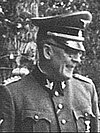This article needs additional citations for verification. (December 2015) |
| 10th SS Panzer Division Frundsberg | |
|---|---|
| 10. SS-Panzerdivision "Frundsberg" | |
 Divisional insignia | |
| Active | 2 January 1943 – 8 May 1945 |
| Country | |
| Branch | |
| Type | Panzer |
| Role | Armoured warfare |
| Size | Division |
| Engagements | |
The 10th SS Panzer Division "Frundsberg" (German: 10. SS-Panzerdivision "Frundsberg")[1] was a German Waffen-SS armoured division during World War II. The division's first battles were in Ukraine in April 1944. Afterwards, the unit was then transferred to the west, where it fought the Allies in France and at Arnhem. The division was moved to Pomerania, then fought south east of Berlin in the Lusatian area until the end of the war.
History
[edit]The division received the honor title "Frundsberg" after the 16th-century German commander Georg von Frundsberg.[2] The division was mainly formed from conscripts. It first saw action at Tarnopol in April 1944 and later took part in the relief of the German troops cut off in the Kamenets-Podolsky pocket.
It was then sent to Normandy to counter the Allied landings, where, along with the SS Division Hohenstaufen, it took part in fighting against the Allied Operation Epsom.[3] They spent the rest of July repulsing British attacks against Hill 112 and Hill 113, most notably during Operation Jupiter. After two weeks of fighting in August against the British during Operation Bluecoat and the Americans at Domfront the division was like many other units encircled at Falaise. They were intended to take part in the counterattack conducted by the II. SS-Panzerkorps but due to the confusion and chaos in the pocket the attack broke down. SS-Panzer-Grenadier-Regiment 21 struck towards St. Lambert but got repulsed. After that the planned attack of the Frundsberg was abandoned and they were ordered to break out between St. Lambert and Chambois. The division suffered heavy casualties and retreated into Belgium before being sent to be reconstituted near Arnhem, where it soon fought the Allied airborne troops during Operation Market Garden at Nijmegen, in the Netherlands, when together with the 9th SS Panzer division it constituted the II SS Panzer Corps.[4] The division however suffered heavy losses in the ensuing counter offensive against the Nijmegen salient in early October. After rebuilding, it fought in the Alsace in January 1945. It was then sent to the Eastern Front, where it fought against the Red Army in Pomerania and then Saxony. Encircled in the Halbe Pocket, the division effected a breakout and retreated through Moritzburg, before reaching the area of Teplice in Czechoslovakia, where the division surrendered to the US Army at the end of the war.[5]
Notable personnel
[edit]German writer and Nobel laureate Günter Grass was trained as a tank crewman with the SS division at the age of 17 in November 1944. He was wounded in action on 25 April 1945 and captured in a hospital.[6] He did not reveal until 2006 that he had been a member of the Waffen-SS.[7]
Organisation
[edit]The organisation structure of this SS formation was as follows:[8]
| Designation (English)[9] | Designation (German)[10] |
|---|---|
|
|
Commanders
[edit]| No. | Portrait | Commander | Took office | Left office | Time in office |
|---|---|---|---|---|---|
| 1 | SS-Standartenführer Michael Lippert (1897–1969) | 1 February 1943 | 15 February 1943 | 14 days | |
| 2 | SS-Gruppenführer Lothar Debes (1890–1960) | 15 February 1943 | 15 November 1943 | 273 days | |
| 3 | SS-Gruppenführer Karl Fischer von Treuenfeld (1885–1946) | 15 November 1943 | 27 April 1944 | 164 days | |
| 4 | SS-Brigadeführer Heinz Harmel (1906–2000) | 27 April 1944 | 28 April 1945 | 1 year, 1 day | |
| 5 | SS-Obersturmbannführer Franz Roestel (1902–1974) | 28 April 1945 | 8 May 1945 | 10 days |
Area of operations
[edit]- France, (January 1943 – March 1944 on formation)
- Eastern Front, Southern sector (March – April 1944)
- Poland, (April – June 1944)
- France, (June – September 1944)
- Belgium & the Netherlands, (September – October 1944)
- West Germany, (October 1944 – February 1945)
- Northwest Germany, (February – March 1945)
- East Germany and Czechoslovakia, (March – May 1945)
- Surrender and disbandment
See also
[edit]- List of Waffen-SS units
- SS Panzer Division order of battle
- List of military units named after people
References
[edit]- ^ Official designation in German language as to "Bundesarchiv-Militärarchiv" in Freiburg im Breisgau, stores of the Wehrmacht and Waffen-SS.
- ^ Tucker-Jones, A. (2022:91). Hitler's Armed SS: The Waffen-SS at War, 1939–1945. United Kingdom: Pen and Sword.
- ^ Zetterling, pp. 298, 305
- ^ "Defending Arnhem © 2006". Archived from the original on 24 April 2019. Retrieved 22 March 2018.
- ^ Georg Tessin, Verbände und Truppen der deutschen Wehrmacht und Waffen-SS, Vol. III, p. 188, Osnabrück: Biblio Verlag, 1974
- ^ Irving, John (19 August 2006). "Günter Grass is my hero, as a writer and a moral compass". The Guardian. London. Archived from the original on 20 August 2006. Retrieved 19 August 2006.
- ^ "Günter Grass im Interview: 'Warum ich nach sechzig Jahren mein Schweigen breche'". Frankfurter Allgemeine Zeitung. Archived from the original on 8 August 2009. Retrieved 31 October 2010.
- ^ GORDON WILLIAMSON: "The SS Hitler's Instrument of the power"; published by KAISER; appendix, page 244, "Schlachtordnung der Waffen-SS / Waffen-SS order of battle"; copyright 1994 by Brown Packaging Books Ltd., London.
- ^ MILITÄRISCHES STUDIENGLOSAR ENGLISCH Teil II/ Teil III, Deutsch – Englisch, Abkürzung Begriff, Bundessprachenamt (Stand Januar 2001).
- ^ Official designation as to "Bundesarchiv-Militärarchiv" in Freiburg im Breisgau, stores of the Wehrmacht and Waffen-SS.
Bibliography
[edit]- Zetterling, Niklas (2019). Normandy 1944: German Military Organization, Combat Power and Organizational Effectiveness (Fully revised ed.). Philadelphia, Pennsylvania: Casemate. ISBN 978-1-61200-816-5.



